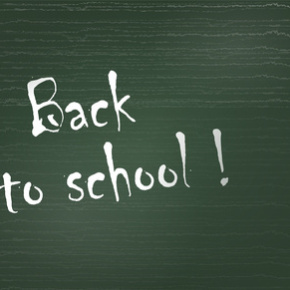 As the beginning of school approaches or, perhaps, has already started, many kids with ADHD/ADD can feel a mix of excitement and dread. Some are excited to see their friends again but dread the start of the academic year. Others would just prefer to avoid the whole scene–social and academic. Often, they are sad to say goodbye to the freedoms of summer and the pleasure of homework-free days. Making this transition back to school can be challenging for even the most well adapted kids who don’t have the challenges of ADHD to contend with. To beat the ADHD Back to School Blues, you have to help your child or teen navigate this shift to school by easing them into the changes ahead. Such support requires looking back and looking forward to identify and build upon successes and lessons from the previous year. Try these steps: 1) Talk about the return to school by reviewing with your child or teen a few positives and negatives about going back–being as specific as possible.
As the beginning of school approaches or, perhaps, has already started, many kids with ADHD/ADD can feel a mix of excitement and dread. Some are excited to see their friends again but dread the start of the academic year. Others would just prefer to avoid the whole scene–social and academic. Often, they are sad to say goodbye to the freedoms of summer and the pleasure of homework-free days. Making this transition back to school can be challenging for even the most well adapted kids who don’t have the challenges of ADHD to contend with. To beat the ADHD Back to School Blues, you have to help your child or teen navigate this shift to school by easing them into the changes ahead. Such support requires looking back and looking forward to identify and build upon successes and lessons from the previous year. Try these steps: 1) Talk about the return to school by reviewing with your child or teen a few positives and negatives about going back–being as specific as possible.  2) Then look at what successes your child or teen had last year that you would like to see repeated and she would like to see repeated. If you can’t come up with any at first, take some time to think of a few examples. No success is too small to mention. 3) Together, make a list of 3 goals for this year that are achievable and realistic. Keep them simple and concrete. For instance, if your son struggles with math and got a ‘C’ last year, getting an ‘A’ in math may not be a realistic goal for this year but getting a ‘B’ might be. Prioritize these ideals and agree to focus only on Number One for a month. Set a date for a follow-up conversation to check on his progress before moving on to Numbers Two and Three.
2) Then look at what successes your child or teen had last year that you would like to see repeated and she would like to see repeated. If you can’t come up with any at first, take some time to think of a few examples. No success is too small to mention. 3) Together, make a list of 3 goals for this year that are achievable and realistic. Keep them simple and concrete. For instance, if your son struggles with math and got a ‘C’ last year, getting an ‘A’ in math may not be a realistic goal for this year but getting a ‘B’ might be. Prioritize these ideals and agree to focus only on Number One for a month. Set a date for a follow-up conversation to check on his progress before moving on to Numbers Two and Three.  4) Identify worries about the school year with your son or daughter. Your goal is to empower him or her towards feeling a sense of control over any concerns instead of being controlled by them. Strategize some manageable solutions and write them down on an electronic device or on a piece of paper (that you post so it doesn’t get lost) for future reference. 5) Give your child or teen time to adjust to the school routine. It takes ADHD kids longer to re-adjust their internal body clocks and their minds to a new schedule. Good luck and welcome back to school!
4) Identify worries about the school year with your son or daughter. Your goal is to empower him or her towards feeling a sense of control over any concerns instead of being controlled by them. Strategize some manageable solutions and write them down on an electronic device or on a piece of paper (that you post so it doesn’t get lost) for future reference. 5) Give your child or teen time to adjust to the school routine. It takes ADHD kids longer to re-adjust their internal body clocks and their minds to a new schedule. Good luck and welcome back to school!
Month: August 2014
Savor the Summer and Take Your ADHD Kids Outside
 As we head into the last weeks of summer and for some, the early return to school, it’s worth taking some time to savor the great outdoors. Spending time in nature is beneficial and fun for all of us: we can kick off our shoes and wade into the ocean, hike to a beautiful vista or just have a picnic in our own backyards. It’s especially great for kids with ADHD. When any of us venture outside to a beach, park or any green spot, our entire demeanor shifts. We shed some of the stress of our daily lives, feel more relaxed and connect with the atmosphere around us. Children, teens and adults start to feel a welcome sense of spaciousness and freedom. For kids with ADHD, this freedom is often sorely needed.
As we head into the last weeks of summer and for some, the early return to school, it’s worth taking some time to savor the great outdoors. Spending time in nature is beneficial and fun for all of us: we can kick off our shoes and wade into the ocean, hike to a beautiful vista or just have a picnic in our own backyards. It’s especially great for kids with ADHD. When any of us venture outside to a beach, park or any green spot, our entire demeanor shifts. We shed some of the stress of our daily lives, feel more relaxed and connect with the atmosphere around us. Children, teens and adults start to feel a welcome sense of spaciousness and freedom. For kids with ADHD, this freedom is often sorely needed.  Children and teens with ADHD need a chance to let go from the pressures of all things that they struggle to remember to do and from not feeling good enough at doing them. They spend so much time trying to focus, stay organized and correct their mistakes that a break from these pressures is a welcome relief. On a family excursion outdoors, they can just be in the moment. They can enjoy the diversity of outside activities and explore the many facets of the natural environment. They may be happy just to be in a different physical space and do nothing at all. These experiences in nature can be very restorative for them and for you as parents too. They also provide ideal times for family fun as the ‘shoulds’ of our daily routines are transformed into games, explorations and discoveries. Here are some tips to having a successful summer family outings with ADHD kids or teens: 1. Pick a location that offers something for everyone and doesn’t require much planning. Talk with your family about the experience and what people want to do so you can all collaborate on making a good experience for everyone. 2. Limit your expectations. Whatever happens has to be okay with you and okay with your child. Share your hope for the day and listen to theirs. 3. Give your teen or child a few specific, simple tasks to do in preparation that are written down and can be checked off. This gives them more practice in developing those ever-needed executive planning and organizing skills. 4. Create some guidelines about appropriate behaviors for the excursion (not more than 3 because the kids won’t likely remember them). These should revolve around safety primarily and be logical and explicit (e.g. no swimming alone or without permission, no hiking away from the group, no wandering off from the picnic area). Remind your child or teen of these 3 guidelines as you arrive at the location. 5. Focus on the positive. There will likely be a blip or two. Something may happen that will frustrate you or your child. Take a deep breath, focus on what’s most important and help him/her recalibrate. You could both try paying attention to something appealing in the nature around you to help you move on. Enjoy your adventures! Follow me on Twitter to learn more about my integrative strategies for attention, behavior and learning @drsharonsaline!
Children and teens with ADHD need a chance to let go from the pressures of all things that they struggle to remember to do and from not feeling good enough at doing them. They spend so much time trying to focus, stay organized and correct their mistakes that a break from these pressures is a welcome relief. On a family excursion outdoors, they can just be in the moment. They can enjoy the diversity of outside activities and explore the many facets of the natural environment. They may be happy just to be in a different physical space and do nothing at all. These experiences in nature can be very restorative for them and for you as parents too. They also provide ideal times for family fun as the ‘shoulds’ of our daily routines are transformed into games, explorations and discoveries. Here are some tips to having a successful summer family outings with ADHD kids or teens: 1. Pick a location that offers something for everyone and doesn’t require much planning. Talk with your family about the experience and what people want to do so you can all collaborate on making a good experience for everyone. 2. Limit your expectations. Whatever happens has to be okay with you and okay with your child. Share your hope for the day and listen to theirs. 3. Give your teen or child a few specific, simple tasks to do in preparation that are written down and can be checked off. This gives them more practice in developing those ever-needed executive planning and organizing skills. 4. Create some guidelines about appropriate behaviors for the excursion (not more than 3 because the kids won’t likely remember them). These should revolve around safety primarily and be logical and explicit (e.g. no swimming alone or without permission, no hiking away from the group, no wandering off from the picnic area). Remind your child or teen of these 3 guidelines as you arrive at the location. 5. Focus on the positive. There will likely be a blip or two. Something may happen that will frustrate you or your child. Take a deep breath, focus on what’s most important and help him/her recalibrate. You could both try paying attention to something appealing in the nature around you to help you move on. Enjoy your adventures! Follow me on Twitter to learn more about my integrative strategies for attention, behavior and learning @drsharonsaline!
